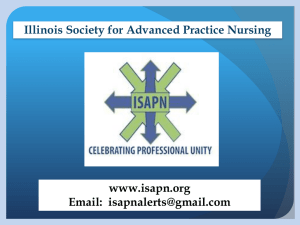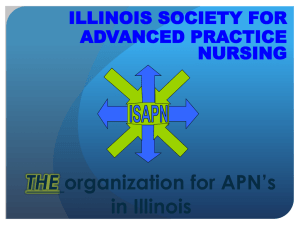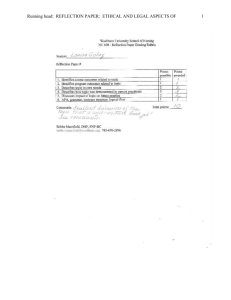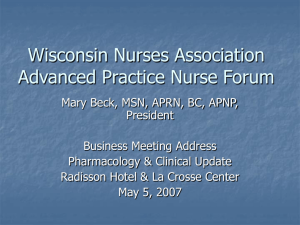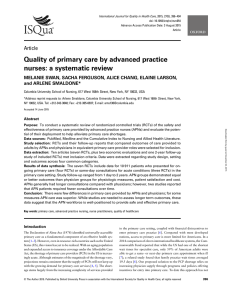Scientific poster example - Illinois Society for Advanced Practice
advertisement
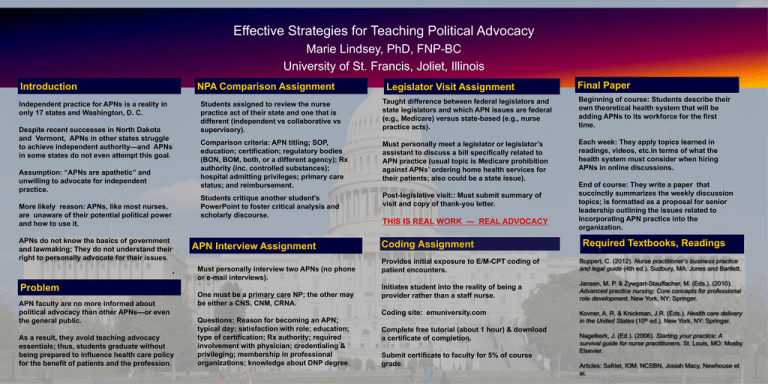
Effective Strategies for Teaching Political Advocacy Marie Lindsey, PhD, FNP-BC University of St. Francis, Joliet, Illinois Introduction NPA Comparison Assignment Independent practice for APNs is a reality in only 17 states and Washington, D. C. Despite recent successes in North Dakota and Vermont, APNs in other states struggle to achieve independent authority—and APNs in some states do not even attempt this goal. Assumption: “APNs are apathetic” and unwilling to advocate for independent practice. More likely reason: APNs, like most nurses, are unaware of their potential political power and how to use it. APNs do not know the basics of government and lawmaking; They do not understand their right to personally advocate for their issues. • Problem APN faculty are no more informed about political advocacy than other APNs—or even the general public. As a result, they avoid teaching advocacy essentials; thus, students graduate without being prepared to influence health care policy for the benefit of patients and the profession. Legislator Visit Assignment Final Paper Students assigned to review the nurse practice act of their state and one that is different (independent vs collaborative vs supervisory). Taught difference between federal legislators and state legislators and which APN issues are federal (e.g., Medicare) versus state-based (e.g., nurse practice acts). Beginning of course: Students describe their own theoretical health system that will be adding APNs to its workforce for the first time. Comparison criteria: APN titling; SOP, education; certification; regulatory bodies (BON, BOM, both, or a different agency); Rx authority (inc. controlled substances); hospital admitting privileges; primary care status; and reimbursement. Must personally meet a legislator or legislator’s assistant to discuss a bill specifically related to APN practice (usual topic is Medicare prohibition against APNs’ ordering home health services for their patients; also could be a state issue). Each week: They apply topics learned in readings, videos, etc.in terms of what the health system must consider when hiring APNs in online discussions. Students critique another student’s PowerPoint to foster critical analysis and scholarly discourse. Post-legislative visit:: Must submit summary of visit and copy of thank-you letter. APN Interview Assignment Must personally interview two APNs (no phone or e-mail interviews). One must be a primary care NP; the other may be either a CNS, CNM, CRNA. Questions: Reason for becoming an APN; typical day; satisfaction with role; education; type of certification; Rx authority; required involvement with physician; credentialing & privileging; membership in professional organizations; knowledge about DNP degree. THIS IS REAL WORK --- REAL ADVOCACY Coding Assignment End of course: They write a paper that succinctly summarizes the weekly discussion topics; is formatted as a proposal for senior leadership outlining the issues related to incorporating APN practice into the organization. Required Textbooks Required Textbooks, Textbooks Readings Provides initial exposure to E/M-CPT coding of patient encounters. Buppert, C. (2012). Nurse practitioner’s business practice and legal guide (4th ed.). Sudbury, MA: Jones and Bartlett. Initiates student into the reality of being a provider rather than a staff nurse. Jansen, M. P. & Zywgart-Stauffacher, M. (Eds.). (2010). Advanced practice nursing: Core concepts for professional role development. New York, NY: Springer. Coding site: emuniversity.com Kovner, A. R. & Knickman, J.R. (Eds.). Health care delivery in the United States (10th ed.). New York, NY: Springer. Complete free tutorial (about 1 hour) & download a certificate of completion. Submit certificate to faculty for 5% of course grade. Nagelkerk, J. (Ed.). (2006). Starting your practice: A survival guide for nurse practitioners. St. Louis, MO: Mosby Elsevier. Articles: Safriet, IOM, NCSBN, Josiah Macy, Newhouse et al.
